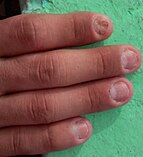Nail biting
| Nail biting | |
|---|---|
 | |
| Fingers of a nail-biter. | |
| Specialty | Pediatrics, psychiatry |
| Risk factors | Damaged cuticles, damaged nails, hangnails, etc. |
Nail biting, also known as onychophagy or onychophagia, is an oral compulsive habit of biting one's fingernails. It is sometimes described as a parafunctional activity, the common use of the mouth for an activity other than speaking, eating, or drinking.
Nail biting is very common, especially amongst children. 25–35 percent of children bite nails. More pathological forms of nails biting are considered an
Signs and symptoms
Nail biting may lead to harmful effects to the fingers, like infections. These consequences are directly derived from the physical damage of biting or from the hands becoming an infection
The ten fingernails are usually equally bitten to approximately the same degree.[4] Often, the adjacent skin is bitten off, too, which is called perionychophagia, a special case of dermatophagia. Biting nails can lead to broken skin on the cuticle. When cuticles are improperly removed, they are susceptible to microbial and viral infections such as paronychia. Saliva may then redden and infect the skin.[2][4] In rare cases, fingernails may become severely deformed after years of nail biting due to the destruction of the nail bed.[2][5]
Nail biting may have an association with oral problems, such as
Nail-biting can be a source of guilt and shame feelings in the nail biter, a reduced quality of life, and increased stigmatization in the inner family circles or at a more societal level.[2][7]
Related disorders
Other body-focused repetitive behaviors include onychotillomania (nail picking), excoriation disorder (skin picking), dermatophagia (skin biting), and trichotillomania (the urge to pull out hair), and all of them tend to coexist with nail biting.[2][8] As an oral parafunctional activity, it is also associated with bruxism (tooth clenching and grinding), and other habits such as pen chewing and cheek biting.[9]
In children nail biting most typically co-occurs with
Treatment
The most common treatment, which is cheap and widely available, is to apply a clear, bitter-tasting nail polish to the nails. Normally denatonium benzoate is used, the most bitter chemical compound known. The bitter flavor discourages the nail-biting habit.[12]
Another treatment for chronic nail biters is the usage of a dental deterrent device that prevents the front teeth from damaging the nails and the surrounding cuticles. After about two months, the device leads to a full oppression of the nail biting urge.[18]
Evidence on the efficacy of drugs is very limited, and they are not routinely used.
Nail cosmetics can help to ameliorate nail biting social effects.[20]
Independently of the method used, parental education is useful in the case of young nail biters to maximize the efficacy of the treatment programs, as some behaviors by the parents or other family members may be helping to perpetuate the problem.[2] For example, punishments have been shown to be not better than placebo, and in some cases may even increase the nail biting frequency.[2]
Epidemiology

While it is rare before the age of three,
References
- ^ "Impulse control disorder". SteadyHealth. 30 December 2010. Retrieved 28 April 2012.
- ^ PMID 23358880.
- ISBN 9780511711930.
- ^ S2CID 208874278.
- S2CID 71984361.
- ^ PMID 18675214.
- PMID 24535041.
- ^ PMID 16402755.
- ISBN 0443071063.
- PMID 20004481.
- S2CID 46664252.
- PMID 8881096.
- PMID 21549664.
- PMID 24130603.
- ^ Penzel, Fred. "Skin picking and nail biting: related habits". Western Suffolk Psychological Services. Retrieved 2008-03-22.
- PMID 21620478.
- S2CID 16277609.
- ^ Davinroy, Donald L. (Oct 2, 2008), Nail biting deterrent device and method, retrieved 2016-09-29
- ^ PMID 23651231.
- S2CID 40739671.
- PMID 23756561.
External links
 Media related to Onychophagia at Wikimedia Commons
Media related to Onychophagia at Wikimedia Commons
